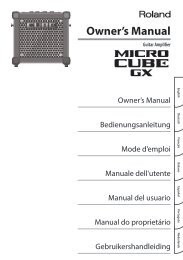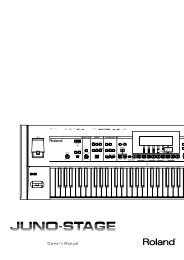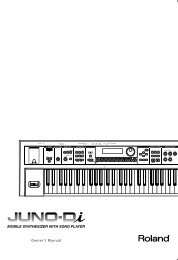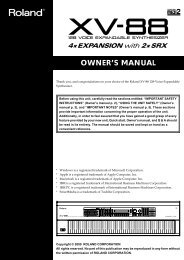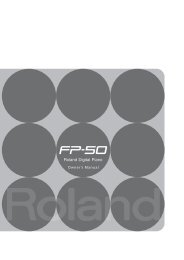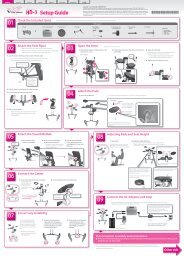You also want an ePaper? Increase the reach of your titles
YUMPU automatically turns print PDFs into web optimized ePapers that Google loves.
Erasing unwanted data (Erase)<br />
fig.PTNERS<br />
This operation erases part (or all) of the data in a pattern.<br />
Display Explanation Setting<br />
Press the part button [R] or [1]–[7] of the part whose data you<br />
wish to erase, getting its indicator to light.<br />
Deleting unwanted measures<br />
(Delete Measure)<br />
fig.PTNDEL<br />
This operation deletes unwanted measures from a pattern,<br />
bringing the previous and subsequent measures together. If<br />
the pattern contains data following the deleted range, the<br />
performance data for that part will become shorter by the<br />
number of measures that were deleted. If you specified that<br />
the deletion be performed on all parts, this operation will<br />
shorten the pattern itself.<br />
fig.7-01<br />
Specify the range of measures<br />
that will be erased.<br />
The CURRENT display indicates<br />
the first measure,<br />
and the NEXT display indicates<br />
the last measure.<br />
1 2 3 4 5 6<br />
1 2 3 4 5<br />
001–<br />
END<br />
Display Explanation Setting<br />
Specify the range of measures<br />
that will be deleted.<br />
The CURRENT display indicates<br />
the first measure,<br />
and the NEXT display indicates<br />
the last measure.<br />
001–<br />
END<br />
Press the part button [R] or [1]–[7] of the part whose measure<br />
you wish to delete, getting its indicator to light.<br />
Chapter 6. Creating an Original Pattern<br />
Inserting blank measures<br />
(Insert Measure)<br />
fig.PTNINS<br />
This operation inserts blank measures between the specified<br />
measure of the pattern and the next measure. If you want to<br />
add a performance in the middle of a pattern, you can use<br />
this operation to insert one or more blank measures, and then<br />
record the additional performance. The time signature of the<br />
inserted measure(s) will be the same as the time signature<br />
that precedes the inserted location.<br />
fig.7-02<br />
1 2<br />
Display Explanation Setting<br />
Press the part button [R] or [1]–[7] of the part you wish to<br />
insert measure, getting its indicator to light.<br />
Shifting the pitch (Transpose)<br />
fig.PTNTPS<br />
3 4 5<br />
1 2 23 4 5 6<br />
CURRENT display:<br />
Specify the measure at<br />
which the blank measure(s)<br />
will be inserted.<br />
* For the example shown<br />
above, select step 2.<br />
NEXT display:<br />
Specify the number of<br />
measures that will be inserted.<br />
* It is not possible to<br />
specify a number that<br />
would cause the pattern<br />
to be longer than 32<br />
measures after<br />
insertion.<br />
001–<br />
END<br />
1–32<br />
This operation shifts the note numbers (pitch) of a part in the<br />
pattern. You can transpose in a +/-2 octave range.<br />
Display Explanation Setting<br />
Specify the amount of<br />
transposition. Each increase<br />
(decrease) of 1 will<br />
raise (lower) the pitch by a<br />
semitone.<br />
-24–0–24<br />
Press the part button [R] or [1]–[7] of the part that you wish<br />
to transpose, getting its indicator to light.<br />
67<br />
Chapter 6



